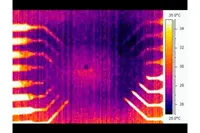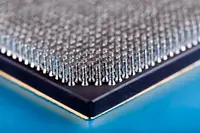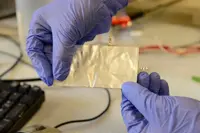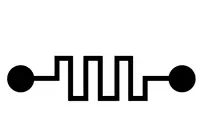Electronics News
Archive : 7 April 2015 год
 Inspired by the way living organisms have evolved, researchers from Durham University and the University of São Paulo-USP in Brazil are exploring similar 'evolutionary' methods in order to create information processing devices.
Inspired by the way living organisms have evolved, researchers from Durham University and the University of São Paulo-USP in Brazil are exploring similar 'evolutionary' methods in order to create information processing devices.
Inspired by the way living organisms have evolved, researchers from Durham University and the University of São Paulo-USP in Brazil are exploring similar 'evolutionary' methods in order to create information processing devices.
In a paper published in the Journal of Applied Physics, the group describes using single walled carbon nanotube composites (SWCNTs) as a material in 'unconventional' computing. By studying the mechanical and electrical properties of the materials, the team discovered a correlation between the concentration, viscosity and conductivity of SWCNTs and the computational capability of the composite.
"Instead of creating circuits from arrays of discrete components, our work takes a random disordered material and then 'trains' the material to produce a desired output," said Mark Massey from Durham University.
This approach – called 'evolution in materio' – blends materials science, engineering and computer science. Although still in its early stages, the concept has already shown that, by using an approach similar to evolution, materials can be trained to mimic electronic circuits without thneeding to design the material structure in a specific way.
"The material we use in our work is a mixture of carbon nanotubes and polymer, which creates a complex electrical structure," explained Massey. "When voltages (stimuli) are applied at points of the material, its electrical properties change. When the correct signals are applied to the material, it can be trained – or 'evolved' – to perform a useful function."
While the group doesn't expect to see its method compete with high silicon computers, it believes it could turn out to be a complementary technology. "With more research, it could lead to new techniques for making electronics devices," he noted, adding future applications could include analogue signal processing or low power, low cost devices.
Author
Graham Pitcher
Source: www.newelectronics.co.uk
 Looking to bring a significant boost in capability to those developing FPGA based satellite applications, Microsemi has launched the RTG4 family.
Looking to bring a significant boost in capability to those developing FPGA based satellite applications, Microsemi has launched the RTG4 family.
"Satellites have more capable sensors, better resolution imagers and faster downlinks," said Ken O'Neill, Microsemi's director of marketing, space and aviation. "Operators want more and more data to be sent back, regardless of what the satellite is, and it's getting harder to squeeze extra data into the downlink. So there is the need to more on board processing and higher performance electronics."
Previous FPGAs for space applications have had limited capacity. "The biggest part before had 20,000 logic elements (LE) and ran at 100MHz," O'Neill noted. "The RTG4 range has up to 150,00 LEs, 462 MAC blocks and runs at 300MHz. This is equivalent to an x20 improvement in signal processing ability." A part with 77,000 LEs is in development
Based on 65nm reprogrammable flash technology, RTG4 devices are said to be completely immune to radiation induced configuration upsets and O'Neill said that 'steps have been taken' to harden the parts against total dose – the long term accumulation of charge.
Key features include: 24 serial transceivers running at up to 3.125Gbit/s; SpaceWire clock and data recovery circuits; and more than 5 Mbit of on-board SRAM.
Engineering samples of the 150k LE device, which will be supplied in a ceramic grid package, are available now, with samples of the 77k device planned for early 2016.
Author
Graham Pitcher
Source: www.newelectronics.co.uk
 Stanford University scientists say they have invented the first high performance aluminium battery that charges quickly, is long lived and inexpensive, as well as offering a safe alternative to many batteries in use today.
Stanford University scientists say they have invented the first high performance aluminium battery that charges quickly, is long lived and inexpensive, as well as offering a safe alternative to many batteries in use today.
"We have developed a rechargeable aluminium battery that may replace existing storage devices, such as alkaline batteries, which are bad for the environment, and lithium-ion batteries, which occasionally burst into flames," said Professor Hongjie Dai. "Our new battery won't catch fire, even if you drill through it."
While researchers have tried for a long time to develop a commercially viable aluminium-ion battery, they have not succeeded, mainly because they haven't found suitable materials. "People have tried different kinds of materials for the cathode," Prof Dai said. "We accidentally discovered that a simple solution is to use graphite. In our study, we identified a few types of graphite material that give us very good performance."
For the experimental battery, the Stanford team placed the aluminium anode and graphite cathode, along with an ionic liquid electrolyte, inside a flexible polymer coated pouch.
The team says it has achieved major breakthroughs in aluminium battery performance, including ultra fast charging – the Stanford researchers say their prototype can recharge in a minute.
Meanwhile, while aluminium batteries developed previously did not exceed 100 charge-discharge cycles, the Stanford battery withstood more than 7500 cycles without any loss of capacity.
Currently, the battery generates about 2V. "Our battery produces about half the voltage of a typical lithium battery," Prof Dai said. "But improving the cathode material could eventually increase the voltage and energy density. Otherwise, our battery has everything else you'd dream that a battery should have: inexpensive electrodes, good safety, high-speed charging, flexibility and long cycle life."
Author
Graham Pitcher
Source: www.newelectronics.co.uk
 A team of researchers from Northwestern University in the US says it has made a step forward in electronics that could bring 'brain like computing' closer to reality. The work involves developing more complex memristors.
A team of researchers from Northwestern University in the US says it has made a step forward in electronics that could bring 'brain like computing' closer to reality. The work involves developing more complex memristors.
To date, memristors have been two terminal electronic devices, which can only control one voltage channel. However, Mark Hersam, from the University's McCormick School of Engineering, wanted to create a three terminal device that could be used in more complex electronic circuits and systems.
Hersam and his team used single layer molybdenum disulphide (MoS2) in their work. The sheet of MoS2 used by Hersam has a well defined grain boundary; the interface where two different grains come together.
"Because the atoms are not in the same orientation, there are unsatisfied chemical bonds at that interface," Hersam said. "These grain boundaries influence the flow of current, so they can serve as a means of tuning resistance."
According to the team, when a large electric field is applied, the grain boundary moves, causing a change in resistance. By using MoS2, instead of the metal-oxide-metal structure found in a typical memristor, the team created a three terminal memristive device that is widely tunable with a gate electrode.
"With a memristor that can be tuned with a third electrode, we have the possibility to realise a function you could not previously achieve," Hersam said. "A three terminal memristor has been proposed as a means of realising brain like computing and we are actively exploring this possibility in the laboratory."
Author
Graham Pitcher
Source: www.newelectronics.co.uk

